Lunar resources and a new Space Race
With the successful landing of Chang'e 3, the attention of the world's spaceflight enthusiasts and experts alike once again turns towards the moon. These things spawn up discussions about why we should go to the moon, whether there is economical benefit to it, or about the "new space race", as well as the usual complaining about NASA's lack of productivity or that those damn commies is taking muh spaceflight. And to be honest, when these things happen, I can't help but feel a slight annoyance. Many of these things are based upon false premises, or people who live in the 1960's, or general ignorance of spaceflight that results in xenophobia, anti-americanism, armchair experts (I'm being a little bit of a hypocrite here, I'll admit that) schooling others like it's their job and nationalist slapfights. Lunar resources Something I've seen so many times lately is that we can use lunar resources to pay off our debt, make fusion attainabl...

